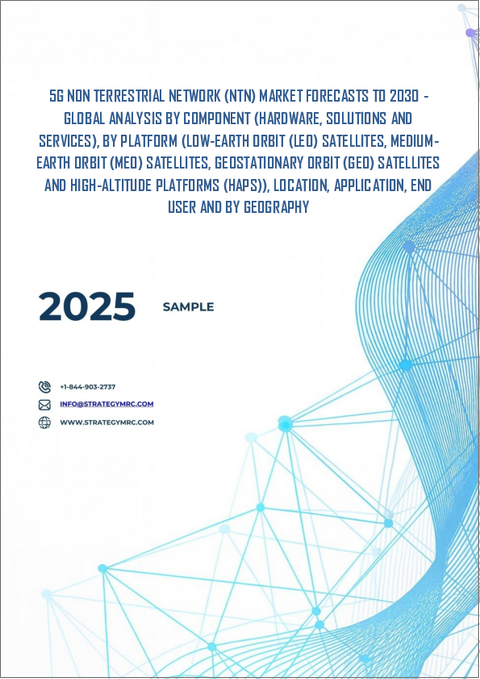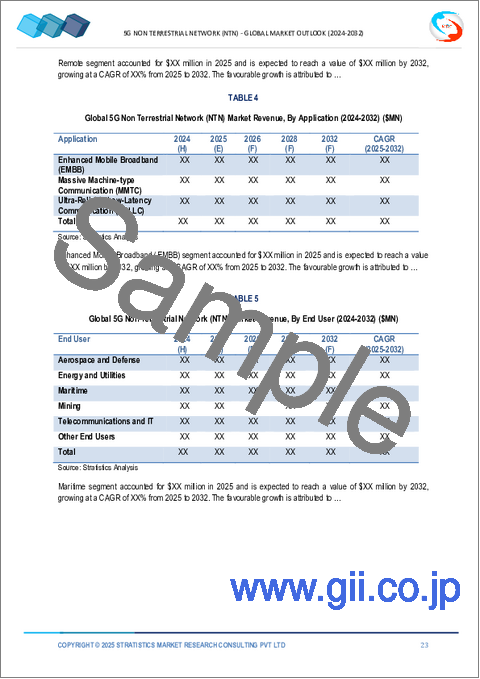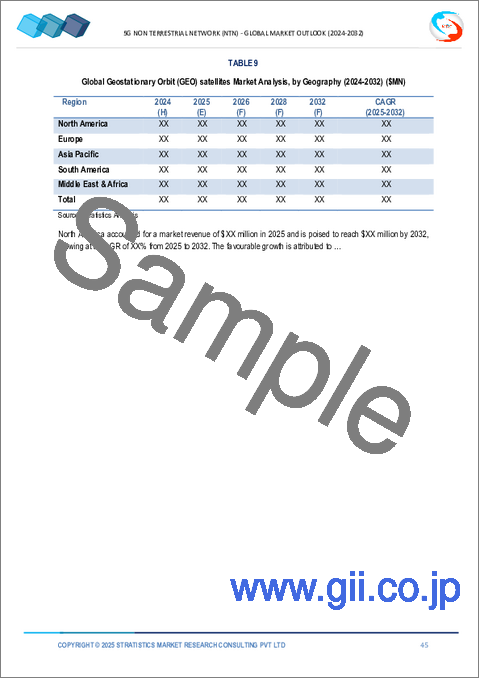|
|
市場調査レポート
商品コード
1423680
5G非地上波ネットワークの世界市場:分析 - コンポーネント別、プラットフォーム別、ロケーション別、用途別、エンドユーザー別、地域別、予測(~2030年)5G Non Terrestrial Network Market Forecasts to 2030 - Global Analysis By Component, By Platform, Location, Application, End User and By Geography |
||||||
カスタマイズ可能
|
|||||||
| 5G非地上波ネットワークの世界市場:分析 - コンポーネント別、プラットフォーム別、ロケーション別、用途別、エンドユーザー別、地域別、予測(~2030年) |
|
出版日: 2024年02月02日
発行: Stratistics Market Research Consulting
ページ情報: 英文 200+ Pages
納期: 2~3営業日
|
全表示
- 概要
- 図表
- 目次
世界の5G非地上波ネットワーク(NTN)の市場規模は、2023年に44億3,000万米ドルに達し、予測期間中にCAGR 38.6%で成長し、2030年には435億7,000万米ドルに達すると予測されています。
5G非地上波ネットワーク(NTN)は、5G接続を地上の制限を超えて拡張するために衛星や高高度プラットフォームを用います。NTNは、衛星コンステレーション、ドローン、成層圏気球を利用して、特に遠隔地やサービスが行き届いていない地域で、より広範な範囲を提供します。NTNは、高速インターネット、低遅延通信を提供し、IoTや重要通信を含む様々な用途をサポートし、地上インフラが不足している地域のデジタルデバイドを埋めることで、世界な接続性を向上させます。
GSMAなどの業界団体の市場統計によると、2020年には無線通信技術が世界の人口の80%以上をカバーするが、地球の陸地面積の40%未満にとどまると言われています。
高速接続を提供
高速接続は、比類のないデータ伝送速度と低遅延接続を提供する能力により、非地上ネットワーク(NTN)市場の極めて重要な促進要因となっています。NTNは衛星や高高度プラットフォームを活用することで、IoT、自律走行車、遠隔操作などの新技術に不可欠な迅速で一貫性のある接続性を確保します。この機能は、シームレスなデータ転送を容易にし、リアルタイムアプリケーション、高解像度コンテンツストリーミング、ミッションクリティカルな通信を可能にします。
技術と規格の急速な変化
技術と規格の急速な進化は、地上波以外のネットワーク市場において大きな抑制要因となっています。5G技術が進歩し、新たなイノベーションが登場するにつれ、規格やプロトコルは絶え間なく進化しています。このダイナミックな環境は、NTNインフラの開発と導入に課題をもたらします。初期技術への投資は、すぐに時代遅れになったり、新しい規格と互換性がなくなったりする可能性があり、陳腐化したり、コストのかかるアップグレードが必要になる可能性があります。
IoTの拡大
NTNは、遠隔地への5G接続を拡張し、農業、鉱業、物流などの業界におけるIoTの普及を可能にします。これらの分野では、地上波の通信エリアが限られた場所で事業を行うことが多くあります。NTNは、リアルタイムのデータ収集、精密な監視と制御を容易にし、運用と効率を最適化します。NTNは、これまで十分なサービスが提供されていなかった地域にもユビキタス接続を提供することで、IoTアプリケーションの可能性を広げ、様々な分野におけるイノベーションと成長を促進します。
地上波ネットワークとの競合
地上波ネットワークは、その能力を継続的に向上させ、広範なカバレッジと改良された技術を提供しています。より高速で低遅延な通信を提供するために進化を続ける地上波ネットワークは、NTN独自のセールスポイントを侵し、市場での地位を脅かす存在となっています。地上波ネットワークがその範囲を拡大するにつれて競争は激化し、NTNソリューションの必要性や競合が制限される可能性があり、NTNプロバイダは市場での関連性を維持するために優れた優位性を示す必要に迫られています。
COVID-19の影響:
COVID-19の大流行は、5G非地上波ネットワーク市場にいくつかの影響を与えました。特に地上インフラが不足している遠隔地では、信頼性と回復力のある接続性の重要性が浮き彫りになった。しかし、パンデミックは、制限、サプライチェーンの混乱、予算の制約により、5G NTN技術の展開とテストの遅延にもつながった。パンデミックの間、遠隔地との接続やIoTソリューションへの需要が高まったことで、NTNの潜在的な価値が浮き彫りになり、当初の挫折にもかかわらず開発が加速しました。
予測期間中、地球低軌道(LEO)衛星セグメントが最大となる見込み
低軌道(LEO)衛星セグメントは、その明確な利点のために支配的であると予測されています。LEO衛星は低遅延を提供し、IoTや自律走行車などのアプリケーションに不可欠なリアルタイム通信を強化します。LEO衛星は、他の衛星タイプに比べ、広範なカバレッジと高いデータ転送レートを可能にします。さらに、世界のインターネット普及のために主要企業や政府がLEO衛星コンステレーションに継続的に投資していることも、このセグメントの成長見通しを後押ししています。これらの要因により、LEO衛星は、接続性を強化し、5G非地上波ネットワーク機能を拡張するための主要な選択肢として位置づけられています。
予測期間中、通信・IT分野のCAGRが最も高くなる見込み
通信・IT分野は、高度な接続ソリューションに対する需要の高まりにより、有利な成長率を示すと予想されます。通信・ITサービスプロバイダやIT企業など、シームレスな高速通信に依存する業界は、5G非地上波ネットワークを活用してカバレッジを拡大し、パフォーマンスを向上させようとしています。これらのネットワークの統合は、IoT、クラウド・サービス、データ集約型業務などの多様なアプリケーションをサポートします。このような通信・IT分野での採用の増加が、予測期間中の同分野の急成長を後押ししています。
最大のシェアを持つ地域
北米は、技術大手や政府の主導による5G非地上波ネットワークへの大規模な投資により、市場シェアをリードする見通しです。先進的なインフラと強固な研究開発がNTNソリューションの展開を支えています。さらに、通信、IoT、航空宇宙などの業界全体で信頼性の高い接続に対する高い需要が市場の成長を促進しています。さらに、主要企業間の戦略的提携や有利な規制の枠組みが、5G NTN技術の採用を促進する上で北米の優位性をより強固なものにしています。
CAGRが最も高い地域
アジア太平洋は、人口増加と新興経済国により市場が大きく成長します。接続性の拡大に対する需要が高まっています。各国政府は、デジタル格差の是正と技術進歩の支援を目的に、NTN技術を含む通信インフラへの投資を積極的に行っています。さらに、この地域の革新的な技術への傾倒は、通信会社やハイテク新興企業による投資の増加と相まって、5G NTNの採用と展開の大幅な成長のための肥沃な土壌を作り出しています。
目次
第1章 エグゼクティブサマリー
第2章 序文
- 概要
- ステークホルダー
- 調査範囲
- 調査手法
- 情報源
第3章 市場動向分析
- 促進要因
- 抑制要因
- 機会
- 脅威
- 用途分析
- エンドユーザー分析
- COVID-19の影響
第4章 ポーターのファイブフォース分析
- 供給企業の交渉力
- 買い手の交渉力
- 代替品の脅威
- 新規参入業者の脅威
- 競合企業間の敵対関係
第5章 世界の5G非地上波ネットワーク(NTN)市場:コンポーネント別
- ハードウェア
- ソリューション
- サービス
- 導入サービス
- 接続サービス
第6章 世界の5G非地上波ネットワーク(NTN)市場:プラットフォーム別
- 地球低軌道(LEO)衛星
- 中軌道(MEO)衛星
- 静止軌道(GEO)衛星
- 高高度プラットフォーム(HAP)
第7章 世界の5G非地上波ネットワーク(NTN)市場:ロケーション別
- 都市
- 田舎
- 遠隔地
- 孤立
第8章 世界の5G非地上波ネットワーク(NTN)市場:用途別
- Enhanced Mobile Broadband (EMBB)
- Massive Machine-type Communication (MMTC)
- Ultra-Reliable Low-Latency Communication (URLLC)
第9章 世界の5G非地上波ネットワーク(NTN)市場:エンドユーザー別
- 航空宇宙・防衛
- エネルギー・公共事業
- 海事
- 鉱業
- 通信・IT
- その他のエンドユーザー
第10章 世界の5G非地上波ネットワーク(NTN)市場:地域別
- 北米
- 米国
- カナダ
- メキシコ
- 欧州
- ドイツ
- 英国
- イタリア
- フランス
- スペイン
- その他の欧州
- アジア太平洋
- 日本
- 中国
- インド
- オーストラリア
- ニュージーランド
- 韓国
- その他のアジア太平洋
- 南米
- アルゼンチン
- ブラジル
- チリ
- その他の南米
- 中東・アフリカ
- サウジアラビア
- アラブ首長国連邦
- カタール
- 南アフリカ
- その他の中東・アフリカ
第11章 主な発展
- 契約、パートナーシップ、コラボレーション、合弁事業
- 買収と合併
- 新製品の発売
- 事業拡大
- その他の主要戦略
第12章 企業プロファイル
- Airbus Defence and Space
- AST & Science
- Boeing
- Eutelsat S.A.
- Globalstar Inc.
- HAPSMobile Inc.
- Intelsat S.A.
- Iridium Communications
- Kuiper Systems LLC
- LeoSat Enterprises
- Lockheed Martin
- Loon LLC
- SES S.A.
- SpaceX
- Telesat
- Thales Alenia Space
- Viasat
- Qualcomm Technologies, Inc.
- Rohde & Schwarz
List of Tables
- Table 1 Global 5G Non Terrestrial Network (NTN) Market Outlook, By Region (2021-2030) ($MN)
- Table 2 Global 5G Non Terrestrial Network (NTN) Market Outlook, By Component (2021-2030) ($MN)
- Table 3 Global 5G Non Terrestrial Network (NTN) Market Outlook, By Hardware (2021-2030) ($MN)
- Table 4 Global 5G Non Terrestrial Network (NTN) Market Outlook, By Solutions (2021-2030) ($MN)
- Table 5 Global 5G Non Terrestrial Network (NTN) Market Outlook, By Services (2021-2030) ($MN)
- Table 6 Global 5G Non Terrestrial Network (NTN) Market Outlook, By Deployment Services (2021-2030) ($MN)
- Table 7 Global 5G Non Terrestrial Network (NTN) Market Outlook, By Connectivity Services (2021-2030) ($MN)
- Table 8 Global 5G Non Terrestrial Network (NTN) Market Outlook, By Platform (2021-2030) ($MN)
- Table 9 Global 5G Non Terrestrial Network (NTN) Market Outlook, By Low-Earth Orbit (LEO) satellites (2021-2030) ($MN)
- Table 10 Global 5G Non Terrestrial Network (NTN) Market Outlook, By Medium-Earth Orbit (MEO) satellites (2021-2030) ($MN)
- Table 11 Global 5G Non Terrestrial Network (NTN) Market Outlook, By Geostationary Orbit (GEO) satellites (2021-2030) ($MN)
- Table 12 Global 5G Non Terrestrial Network (NTN) Market Outlook, By High-Altitude Platforms (HAPs) (2021-2030) ($MN)
- Table 13 Global 5G Non Terrestrial Network (NTN) Market Outlook, By Location (2021-2030) ($MN)
- Table 14 Global 5G Non Terrestrial Network (NTN) Market Outlook, By Urban (2021-2030) ($MN)
- Table 15 Global 5G Non Terrestrial Network (NTN) Market Outlook, By Rural (2021-2030) ($MN)
- Table 16 Global 5G Non Terrestrial Network (NTN) Market Outlook, By Remote (2021-2030) ($MN)
- Table 17 Global 5G Non Terrestrial Network (NTN) Market Outlook, By Isolated (2021-2030) ($MN)
- Table 18 Global 5G Non Terrestrial Network (NTN) Market Outlook, By Application (2021-2030) ($MN)
- Table 19 Global 5G Non Terrestrial Network (NTN) Market Outlook, By Enhanced Mobile Broadband (EMBB) (2021-2030) ($MN)
- Table 20 Global 5G Non Terrestrial Network (NTN) Market Outlook, By Massive Machine-type Communication (MMTC) (2021-2030) ($MN)
- Table 21 Global 5G Non Terrestrial Network (NTN) Market Outlook, By Ultra-Reliable Low-Latency Communication (URLLC) (2021-2030) ($MN)
- Table 22 Global 5G Non Terrestrial Network (NTN) Market Outlook, By End User (2021-2030) ($MN)
- Table 23 Global 5G Non Terrestrial Network (NTN) Market Outlook, By Aerospace and Defense (2021-2030) ($MN)
- Table 24 Global 5G Non Terrestrial Network (NTN) Market Outlook, By Energy and Utilities (2021-2030) ($MN)
- Table 25 Global 5G Non Terrestrial Network (NTN) Market Outlook, By Maritime (2021-2030) ($MN)
- Table 26 Global 5G Non Terrestrial Network (NTN) Market Outlook, By Mining (2021-2030) ($MN)
- Table 27 Global 5G Non Terrestrial Network (NTN) Market Outlook, By Telecommunications and IT (2021-2030) ($MN)
- Table 28 Global 5G Non Terrestrial Network (NTN) Market Outlook, By Other End Users (2021-2030) ($MN)
Note: Tables for North America, Europe, APAC, South America, and Middle East & Africa Regions are also represented in the same manner as above.
According to Stratistics MRC, the Global 5G Non Terrestrial Network (NTN) Market is accounted for $4.43 billion in 2023 and is expected to reach $43.57 billion by 2030 growing at a CAGR of 38.6% during the forecast period. The 5G Non-Terrestrial Network (NTN) employs satellite or high-altitude platforms to extend 5G connectivity beyond terrestrial limitations. It utilizes satellite constellations, drones or stratospheric balloons to provide broader coverage, especially in remote or underserved areas. NTN enhances global connectivity by offering high-speed internet, low-latency communication, supporting various applications, including IoT and critical communications and bridging the digital divide in regions lacking terrestrial infrastructure.
According to market statistics by industrial organizations such as GSMA, in 2020, wireless communications technologies covered more than 80% of the world's population but less than 40% of the Earth's land mass.
Market Dynamics:
Driver:
Offers high-speed connectivity
High-speed connectivity stands as a pivotal driver in the non-terrestrial network (NTN) market due to its ability to provide unparalleled data transmission rates and low-latency connections. NTN, leveraging satellites or high-altitude platforms, ensures rapid and consistent connectivity, which is crucial for emerging technologies like IoT, autonomous vehicles and remote operations. This capability facilitates seamless data transfer, enabling real-time applications, high-resolution content streaming, and mission-critical communications even in remote or underserved regions where traditional terrestrial networks struggle to deliver such high-speed and reliable connections.
Restraint:
Rapid changes in technology and standards
The rapid evolution of technology and standards presents a significant restraint in the non-terrestrial network market. As 5G technology progresses and new innovations emerge, there's a constant evolution in standards and protocols. This dynamic environment poses challenges for NTN infrastructure development and implementation. Investments made in early technologies might quickly become outdated or incompatible with newer standards, leading to potential obsolescence or the need for costly upgrades.
Opportunity:
IoT expansion
NTN extends 5G connectivity to remote areas enabling IoT proliferation in industries such as agriculture, mining and logistics. These sectors often operate in locations with limited terrestrial coverage. NTN facilitates real-time data gathering, precision monitoring and control, optimizing operations and efficiency. By providing ubiquitous connectivity to previously underserved regions, NTN unlocks the potential for transformative IoT applications, fostering innovation and growth in various sectors.
Threat:
Competition from terrestrial networks
Terrestrial networks, continually enhancing their capabilities, offer widespread coverage and improved technologies. As they evolve to provide faster speeds and lower latency, they encroach upon the unique selling points of NTN, challenging its market position. The competition intensifies as terrestrial networks expand their reach, potentially limiting the perceived necessity or competitiveness of NTN solutions and compelling NTN providers to demonstrate superior advantages to sustain relevance in the market.
Covid-19 Impact:
The COVID-19 pandemic affected the 5G non-terrestrial network market in several ways. It highlighted the importance of reliable and resilient connectivity, especially in remote areas where terrestrial infrastructure is lacking. However, the pandemic also led to delays in the deployment and testing of 5G NTN technologies due to restrictions, supply chain disruptions, and budget constraints. The increased demand for remote connectivity and IoT solutions during the pandemic underscored the potential value of NTN, accelerating its development despite initial setbacks.
The low-earth orbit (LEO) satellites segment is expected to be the largest during the forecast period
The Low Earth Orbit (LEO) satellite segment is projected to dominate due to its distinct advantages. LEO satellites offer lower latency, enhancing real-time communication critical for applications like IoT and autonomous vehicles. They enable extensive coverage and higher data transfer rates compared to other satellite types. Additionally, ongoing investments by key players and governments in LEO satellite constellations for global internet coverage bolster this segment's growth prospects. These factors position LEO satellites as the leading choice for enhancing connectivity and expanding 5G non-terrestrial network capabilities.
The telecommunications and IT segment is expected to have the highest CAGR during the forecast period
The telecommunications and IT segment is anticipated to exhibit a lucrative growth rate owing to escalating demand for advanced connectivity solutions. Industries reliant on seamless, high-speed communication, such as telecommunication service providers and IT enterprises, seek to leverage 5G non-terrestrial networks for expanded coverage and enhanced performance. The integration of these networks supports diverse applications like IoT, cloud services and data-intensive operations. This increased adoption across telecommunications and IT sectors drives the segment's rapid growth during the forecast period.
Region with largest share:
North America is poised to lead in market share due to significant investments in 5G non-terrestrial networks, driven by tech giants and government initiatives. Advanced infrastructure, coupled with robust R&D, supports the deployment of NTN solutions. Additionally, a high demand for reliable connectivity across industries like telecommunications, IoT and aerospace fosters market growth. Moreover, strategic collaborations among key industry players and favourable regulatory frameworks further solidify North America's dominance in driving the adoption of 5G NTN technologies.
Region with highest CAGR:
The Asia Pacific region is positioned for significant growth in the market due to its growing population and emerging economies. There's a growing demand for expanded connectivity. Governments are actively investing in telecommunications infrastructure, including NTN technologies, to bridge digital divides and support technological advancements. Moreover, the region's inclination towards innovative technologies, coupled with increasing investments from telecom companies and tech startups, creates fertile ground for substantial growth in 5G NTN adoption and deployment.
Key players in the market
Some of the key players in 5G Non Terrestrial Network (NTN) market include Airbus Defence and Space, AST & Science, Boeing, Eutelsat S.A., Globalstar Inc., HAPSMobile Inc., Intelsat S.A., Iridium Communications, Kuiper Systems LLC, LeoSat Enterprises, Lockheed Martin, Loon LLC, SES S.A., SpaceX, Telesat, Thales Alenia Space, Viasat, Qualcomm Technologies, Inc. and Rohde & Schwarz.
Key Developments:
In September 2023, Rohde & Schwarz and Skylo Technologies are collaborating to establish a device acceptance program for Skylo's non-terrestrial network (NTN). Leveraging Rohde & Schwarz's established device test framework, they will conduct tests on NTN chipsets, modules, and devices to ensure their compatibility with Skylo's test specifications.
In April 2023, NTT and SES partnership to leverage NTT's expertise in networking and enterprise-managed services and SES's unique O3b mPOWER satellites system to develop a new offering that will deliver reliable connectivity to enterprises.
In January 2023, Qualcomm Technologies, Inc. and Keysight Technologies, Inc. built a comprehensive 5G non-terrestrial network (NTN) link. The cooperation seeks to hasten the development of 5G NTN technology by successfully demonstrating call signaling and data transfer using orbit trajectory emulation. This will enable affordable broadband connectivity in remote areas. Through this partnership, Keysight and Qualcomm Technologies are demonstrating their dedication to the global telecommunications sector's advancements in innovation, connection and security.
Components Covered:
- Hardware
- Solutions
- Services
Platforms Covered:
- Low-Earth Orbit (LEO) satellites
- Medium-Earth Orbit (MEO) satellites
- Geostationary Orbit (GEO) satellites
- High-Altitude Platforms (HAPs)
Locations Covered:
- Urban
- Rural
- Remote
- Isolated
Applications Covered:
- Enhanced Mobile Broadband (EMBB)
- Massive Machine-type Communication (MMTC)
- Ultra-Reliable Low-Latency Communication (URLLC)
End Users Covered:
- Aerospace and Defense
- Energy and Utilities
- Maritime
- Mining
- Telecommunications and IT
- Other End Users
Regions Covered:
- North America
- US
- Canada
- Mexico
- Europe
- Germany
- UK
- Italy
- France
- Spain
- Rest of Europe
- Asia Pacific
- Japan
- China
- India
- Australia
- New Zealand
- South Korea
- Rest of Asia Pacific
- South America
- Argentina
- Brazil
- Chile
- Rest of South America
- Middle East & Africa
- Saudi Arabia
- UAE
- Qatar
- South Africa
- Rest of Middle East & Africa
What our report offers:
- Market share assessments for the regional and country-level segments
- Strategic recommendations for the new entrants
- Covers Market data for the years 2021, 2022, 2023, 2026, and 2030
- Market Trends (Drivers, Constraints, Opportunities, Threats, Challenges, Investment Opportunities, and recommendations)
- Strategic recommendations in key business segments based on the market estimations
- Competitive landscaping mapping the key common trends
- Company profiling with detailed strategies, financials, and recent developments
- Supply chain trends mapping the latest technological advancements
Free Customization Offerings:
All the customers of this report will be entitled to receive one of the following free customization options:
- Company Profiling
- Comprehensive profiling of additional market players (up to 3)
- SWOT Analysis of key players (up to 3)
- Regional Segmentation
- Market estimations, Forecasts and CAGR of any prominent country as per the client's interest (Note: Depends on feasibility check)
- Competitive Benchmarking
- Benchmarking of key players based on product portfolio, geographical presence, and strategic alliances
Table of Contents
1 Executive Summary
2 Preface
- 2.1 Abstract
- 2.2 Stake Holders
- 2.3 Research Scope
- 2.4 Research Methodology
- 2.4.1 Data Mining
- 2.4.2 Data Analysis
- 2.4.3 Data Validation
- 2.4.4 Research Approach
- 2.5 Research Sources
- 2.5.1 Primary Research Sources
- 2.5.2 Secondary Research Sources
- 2.5.3 Assumptions
3 Market Trend Analysis
- 3.1 Introduction
- 3.2 Drivers
- 3.3 Restraints
- 3.4 Opportunities
- 3.5 Threats
- 3.6 Application Analysis
- 3.7 End User Analysis
- 3.8 Impact of Covid-19
4 Porters Five Force Analysis
- 4.1 Bargaining power of suppliers
- 4.2 Bargaining power of buyers
- 4.3 Threat of substitutes
- 4.4 Threat of new entrants
- 4.5 Competitive rivalry
5 Global 5G Non Terrestrial Network (NTN) Market, By Component
- 5.1 Introduction
- 5.2 Hardware
- 5.3 Solutions
- 5.4 Services
- 5.4.1 Deployment Services
- 5.4.2 Connectivity Services
6 Global 5G Non Terrestrial Network (NTN) Market, By Platform
- 6.1 Introduction
- 6.2 Low-Earth Orbit (LEO) satellites
- 6.3 Medium-Earth Orbit (MEO) satellites
- 6.4 Geostationary Orbit (GEO) satellites
- 6.5 High-Altitude Platforms (HAPs)
7 Global 5G Non Terrestrial Network (NTN) Market, By Location
- 7.1 Introduction
- 7.2 Urban
- 7.3 Rural
- 7.4 Remote
- 7.5 Isolated
8 Global 5G Non Terrestrial Network (NTN) Market, By Application
- 8.1 Introduction
- 8.2 Enhanced Mobile Broadband (EMBB)
- 8.3 Massive Machine-type Communication (MMTC)
- 8.4 Ultra-Reliable Low-Latency Communication (URLLC)
9 Global 5G Non Terrestrial Network (NTN) Market, By End User
- 9.1 Introduction
- 9.2 Aerospace and Defense
- 9.3 Energy and Utilities
- 9.4 Maritime
- 9.5 Mining
- 9.6 Telecommunications and IT
- 9.7 Other End Users
10 Global 5G Non Terrestrial Network (NTN) Market, By Geography
- 10.1 Introduction
- 10.2 North America
- 10.2.1 US
- 10.2.2 Canada
- 10.2.3 Mexico
- 10.3 Europe
- 10.3.1 Germany
- 10.3.2 UK
- 10.3.3 Italy
- 10.3.4 France
- 10.3.5 Spain
- 10.3.6 Rest of Europe
- 10.4 Asia Pacific
- 10.4.1 Japan
- 10.4.2 China
- 10.4.3 India
- 10.4.4 Australia
- 10.4.5 New Zealand
- 10.4.6 South Korea
- 10.4.7 Rest of Asia Pacific
- 10.5 South America
- 10.5.1 Argentina
- 10.5.2 Brazil
- 10.5.3 Chile
- 10.5.4 Rest of South America
- 10.6 Middle East & Africa
- 10.6.1 Saudi Arabia
- 10.6.2 UAE
- 10.6.3 Qatar
- 10.6.4 South Africa
- 10.6.5 Rest of Middle East & Africa
11 Key Developments
- 11.1 Agreements, Partnerships, Collaborations and Joint Ventures
- 11.2 Acquisitions & Mergers
- 11.3 New Product Launch
- 11.4 Expansions
- 11.5 Other Key Strategies
12 Company Profiling
- 12.1 Airbus Defence and Space
- 12.2 AST & Science
- 12.3 Boeing
- 12.4 Eutelsat S.A.
- 12.5 Globalstar Inc.
- 12.6 HAPSMobile Inc.
- 12.7 Intelsat S.A.
- 12.8 Iridium Communications
- 12.9 Kuiper Systems LLC
- 12.10 LeoSat Enterprises
- 12.11 Lockheed Martin
- 12.12 Loon LLC
- 12.13 SES S.A.
- 12.14 SpaceX
- 12.15 Telesat
- 12.16 Thales Alenia Space
- 12.17 Viasat
- 12.18 Qualcomm Technologies, Inc.
- 12.19 Rohde & Schwarz





